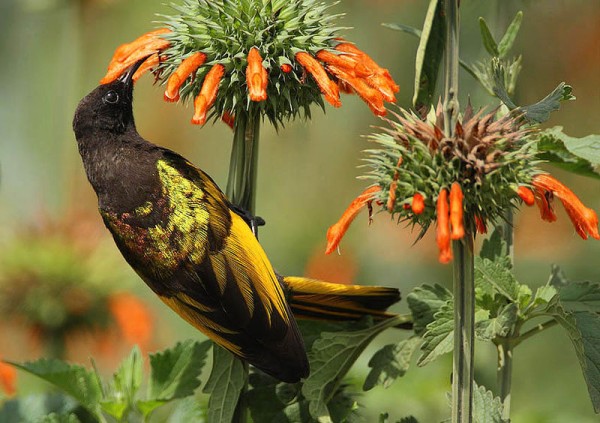In Africa sunbirds fill the ecological niche that hummingbirds fill here. Like hummingbirds, they feed on nectar, have long down-curved bills and come in beautiful iridescent colors. The main difference is that sunbirds perch instead of hover.
Like hummingbirds, sunbirds also pugnaciously defend their nectar sources and spend a lot of time chasing and fighting. What is the advantage in doing this? Doesn’t it cost more energy than peaceable feeding?
In 1975 Gill and Wolf studied the energy expended by territorial golden-winged sunbirds in Kenya. Their results were a bit surprising. It costs less energy per day to defend really good nectar sources than it does to feed at undefended low-nectar flowers.
Here’s the math:
- Undefended flowers have less nectar because so many birds are feeding at them. Foraging burns 4 kilojoules of energy per hour but it takes 8 hours to get enough food. 8 hours * 4 kilojoules/hour = 32 kilojoules burned.
- Defended flowers have twice as much nectar so it takes only 4 hours to get the same energy. 4 hours * 4 kilojoules/hour = 16 kilojoules burned while foraging.
- Defending these flowers is energy intensive (12.5 kilojoules/hour) but if it doesn’t take much time it’s worth it. If it only takes 20 minutes to defend those flowers in that same 8 hour period the results are: 0.33 hour * 12.5 kilojoules/hour = 3.7 kilojoules burned in defense.
- What does a territorial sunbird do with all that extra time? He sits around and watches his flowers. 3.7 hours * 1.7 kilojoules/hour = 6.3 kilojoules spent sitting.
- Therefore his total energy expenditure is 26 kilojoules, a savings of 6 kilojoules in 8 hours.
That’s why hummingbirds are so belligerent at our feeders. They’re making the calculation that defending a great food source is the cheapest way to go.
(Credits:
Photo of a golden-winged sunbird from Wikimedia Commons. Click on the image to see the original.
Today’s Tenth Page is inspired by page 310 of Ornithology by Frank B. Gill.)
